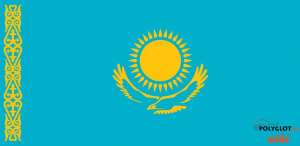Difference between revisions of "Language/Kazakh/Culture/Music-and-Dance"
m (Quick edit) |
m (Quick edit) |
||
| Line 55: | Line 55: | ||
* [https://ich.unesco.org/en/RL/orteke-traditional-performing-art-in-kazakhstan-dance-puppet-and-music-01878 Orteke, traditional performing art in Kazakhstan: dance, puppet and ...] | * [https://ich.unesco.org/en/RL/orteke-traditional-performing-art-in-kazakhstan-dance-puppet-and-music-01878 Orteke, traditional performing art in Kazakhstan: dance, puppet and ...] | ||
* [https://astanatimes.com/2023/03/kazakh-gulder-ensemble-performs-again-in-blazing-celebration-of-national-dance/ Kazakh Gulder Ensemble Performs Again in Blazing Celebration of ...] | * [https://astanatimes.com/2023/03/kazakh-gulder-ensemble-performs-again-in-blazing-celebration-of-national-dance/ Kazakh Gulder Ensemble Performs Again in Blazing Celebration of ...] | ||
==Related Lessons== | |||
* [[Language/Kazakh/Culture/Cuisine-and-Culinary-Art|Cuisine and Culinary Art]] | |||
* [[Language/Kazakh/Culture/Entertainment-and-Nightlife|Entertainment and Nightlife]] | |||
* [[Language/Kazakh/Culture/Visual-Arts-and-Crafts|Visual Arts and Crafts]] | |||
* [[Language/Kazakh/Culture/Festivals-and-Holidays|Festivals and Holidays]] | |||
* [[Language/Kazakh/Culture/Popular-Sports-in-Kazakhstan|Popular Sports in Kazakhstan]] | |||
* [[Language/Kazakh/Culture/Wedding-Celebrations|Wedding Celebrations]] | |||
* [[Language/Kazakh/Culture/Singers|Singers]] | |||
* [[Language/Kazakh/Culture/Kazakhstan-Timeline|Kazakhstan Timeline]] | |||
* [[Language/Kazakh/Culture/Folk-Tales-and-Legends|Folk Tales and Legends]] | |||
{{Kazakh-Page-Bottom}} | {{Kazakh-Page-Bottom}} | ||
Revision as of 12:56, 12 March 2023
Kazakhstan is a country with a rich cultural heritage. Its diverse geography and nomadic history have influenced many aspects of Kazakh culture, including music and dance. Music and dance are an integral part of Kazakh culture and are often performed on important occasions, such as weddings, festivals, and holidays. In this lesson, we will explore the diverse and rich musical and dance traditions of Kazakhstan.
Traditional Kazakh Music
Traditional Kazakh music is characterized by its use of stringed instruments, such as the dombra, a long-necked lute, and the kobyz, a horsehair fiddle. These instruments are often accompanied by percussion instruments, such as the kyl-kobyz, a two-stringed bow instrument, and the shankobyz, a hand-held drum. The two-stringed lute called the Dombyra is the main instrument in traditional Kazakh music. An important expression of Kazakh oral culture, it is used to accompany dances, Kazakh traditional folk instrument orchestra ensembles, the singing of oneself or professional singers (akyn). Kazakh traditional music is typically based on the pentatonic scale.
Kazakh traditional songs are often narrative in nature, telling tales of love, heroism, or everyday life. The songs are sung either individually or in groups, with the audience often joining in. One of the most popular genres of traditional Kazakh music is the kuys, instrumental songs performed on the dombra or kobyz. Unlike other traditional Kazakh music, kuys do not have any lyrics and are purely instrumental.
Many of the traditional Kazakh musical techniques and instruments have been passed down through generations of musicians. Musicians often learn by ear or through formal apprenticeship and training programs. While traditional Kazakh music remains popular, the country has also seen an increase in modern and pop music in recent years.
Traditional Kazakh Dance
Traditional Kazakh dance is characterized by its gracefulness and elegance, as well as its connection to nature and nomadic life. Many traditional Kazakh dances imitate the movements of animals, such as the eagle and the horse, and are often performed in full traditional dress.
One of the most popular traditional Kazakh dances is the kara zhorga, or "black crane," which is performed with slow, graceful motions reminiscent of a crane's movements. Another popular dance is the aytysh, a competitive dance-off between two male dancers vying for the attention of a female dancer. The dancers use a form of stylized martial arts, mixed with dance, to compete for the female dancer's attention.
Like traditional Kazakh music, traditional Kazakh dance has been passed down through generations of dancers. There are many dance schools throughout the country that teach traditional Kazakh dance, and it is often performed at festivals and celebrations.
Modern Kazakh Music and Dance
In addition to traditional Kazakh music and dance, Kazakhstan has also seen an increase in modern and pop music in recent years. This new wave of music is often influenced by Western music and includes genres such as rock, hip-hop, and electronic music.
Similarly, modern Kazakh dance has also been influenced by Western dance styles, including breakdancing and contemporary dance. The popularity of these new dance styles has led to the establishment of numerous dance schools and studios throughout the country.
Conclusion
Kazakh music and dance are an important part of the country's cultural heritage. From traditional folk tunes to modern pop music, Kazakh music remains a vital part of Kazakh culture. Kazakh dance, with its graceful movements and connection to nature, continues to captivate audiences around the world.
Sources:
Sources
- MUSIC AND DANCE IN KAZAKHSTAN | Facts and Details
- Did the Kazakhs Have Their Own Dance Culture and What Are the ...
- Orteke, traditional performing art in Kazakhstan: dance, puppet and ...
- Kazakh Gulder Ensemble Performs Again in Blazing Celebration of ...
Related Lessons
- Cuisine and Culinary Art
- Entertainment and Nightlife
- Visual Arts and Crafts
- Festivals and Holidays
- Popular Sports in Kazakhstan
- Wedding Celebrations
- Singers
- Kazakhstan Timeline
- Folk Tales and Legends
